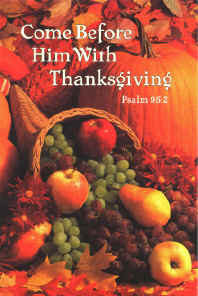Thanksgiving
Second Monday of
October
Enter His gates
with thanksgiving and His courts with praise. Give thanks to Him, bless His
name. (Ps. 100:4)
 In
Canada Thanksgiving is celebrated on the second Monday of October. Thanksgiving in
North America comes from several traditions.
In
Canada Thanksgiving is celebrated on the second Monday of October. Thanksgiving in
North America comes from several traditions.
Before the first Europeans arrived in North America, farmers in Europe held celebrations at harvest time. To give thanks for their good fortune and the abundance of food, the farm workers filled a curved goat's horn with fruit and grain. This symbol was known as a cornucopia or horn of plenty.
The first celebration of Thanksgiving by Europeans in North America occurred in the 16th century. In 1576, Martin Frobisher had set out to find the Spice Islands. In 1578 he landed instead on Baffin Island. The complete absence of trees and a pitiless terrain of unrelieved rock and permafrost must have been daunting. Nonetheless, he and his men had survived a long and dangerous ocean crossing, and he held a formal ceremony of Thanksgiving to God for their survival. Other settlers arrived and continued these ceremonies.
Almost thirty years later, the French explorer Samuel de Champlain celebrated in 1606 with the gentlemen in his colony, at the Habitation in Port Royal, Nova Scotia. They formed the ‘Order of Good Cheer’, and gladly shared their food with their Indian neighbours. The tradition of tables laden with roasted meat, fowl and fish, freshly harvested vegetables, and fine wine, began with the Habitation colonists.
In 1621, Pilgrims from England arrived in the New World, holding the first Thanksgiving celebration at Plymouth, Massachusetts. They had had a difficult voyage and winter, and by the time that spring arrived only half of the settlers who had sailed were still alive. However, some friendly Indians showed them how to hunt animals and catch fish, told them what berries and nuts were good to eat, and gave them some seeds and taught them how to plant and cultivate them.
When the fall came, the settlers had had a good harvest. This was the time that Harvest Home was celebrated in England, and the leader of the Pilgrims decided that their first harvest should be an especially big celebration. The custom of Thanksgiving Day spread from the Pilgrim settlement in Plymouth to the other English colonies in what is now United States. The USA celebrates Thanksgiving on the fourth Thursday of November and has done so since 1863, when President Abraham Lincoln formally declared it a holiday.
Records of 1710 at Port Royal, Nova Scotia, note an October 10 Thanksgiving celebration to mark the return of the town to the English during a turbulent period of European wars. In 1763, Halifax celebrated the end of the Seven Years’ War with a similar ceremony.
Following the American Revolution, numerous
Loyalists arrived in Canada and spread the Thanksgiving celebration to other parts of the country.
Many of the new English settlers from Great Britain were also used to having a
harvest celebration in their churches every autumn.
In 1879 Parliament
declared November 6th a day of Thanksgiving and a national holiday. Over the
years many dates were used for Thanksgiving, the most popular being the 3rd
Monday in October. After World War I, both Armistice Day and Thanksgiving were
celebrated on the Monday of the week in which November 11th occurred. In 1931
the two days became separate holidays and Armistice Day was renamed Remembrance
Day.
Finally, on January 31st, 1957,
Parliament proclaimed “A Day of General Thanksgiving
to Almighty God for the bountiful harvest with which Canada has been blessed
... to be observed on the 2nd Monday in October.”
Acknowledgements:
Text adapted from Sholay
Specials (no longer available)
Image from
Saint James' church bulletin